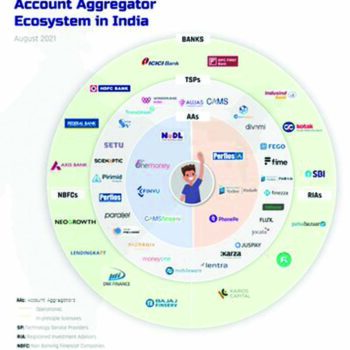
Last week India launched yet another ambitious plan to fundamentally alter status quo. This time with the intent of empowering individuals and small enterprises through their personal data.
The Account Aggregator (AA) framework, enabling this monetisation of personal data, was launched at a virtual event hosted by iSPIRIT, a group of technology evangelicals based out of Bengaluru who helped create the India Stack architecture powering UPI or the Unified Payments Interface. The eight authorised entities, including State Bank of India, IDFC Bank and ICICI, are under the regulatory purview of Reserve Bank of India (RBI).
Last week India unveiled the #AccountAggregator network, a financial data-sharing system. Account Aggregator empowers the individual with control over their personal financial data, which otherwise remains in silos.
Read morehttps://t.co/LIevV3SgVz pic.twitter.com/VyhwAhrgZ0
— Ministry of Finance (@FinMinIndia) September 10, 2021
The AA framework enables consent-based monetisation of data, particularly of individuals and small enterprises, which was otherwise invisible to most financial intermediaries. Once Parliament signs off on the pending data privacy law, all the parts of this strategy will be in place.
This exchange of verified individual data will not only spur another round of financial inclusion—with more individuals and small enterprises empowered by their personal data to access credit—and the ongoing Fintech revolution in India but it could stoke a fresh boom in consumption—something India so desperately needs in a post-Covid world.
Data Democracy

For the uninitiated, the AA is very similar to a financial intermediary. There is a big difference though. The AA’s oversee the exchange of an individual’s data instead of facilitating money transfers. It means that all the data—whether it be wealth or health statistics—of an individual can now be captured in a digital environment and shared using an AA.
This transaction will be consent-based and the AA is data-blind—neither can these entities view the data passing through them nor can they store it. And companies who wish to use this data for commercial use will have to pay for it—the tariff for which will vary, depending on whether it is being used once or multiple times. Hitherto this value was either unrealised or the data was being harvested for free by various platforms.
Something that Nandan Nilekani, the former head of the Unique Identification Authority of India (UIDAI), chairman of Infosys and a key backer of AA, often sums up so succinctly: Indians are economically poor but data-rich.
The launch of AA is seeking a convergence of these two extremes through data empowerment. Exactly why this is akin to another “Freedom at Midnight” moment. And what a coincidence for this to happen in the 75th year of Independent India. Indeed, it is another tryst with destiny.
Data Rich
Among the first uses for the AA framework will be in creating first time credit opportunities for demographic segments like micro, small and medium enterprises (MSMEs).
Despite contributing about a third of the country’s national income, employing a quarter of the country’s 400 million-plus workforce and possessing an impressive appetite for risk, their access to formal credit lines are limited. This is largely because of the informal nature of their economic status—which limit their ability to generate metrics to be eligible for conventional loans from banks.
All this is about to change. The enabling AA framework happens at a time when FinTechs have already begun to disrupt the business of lending by focusing on metrics other than collaterals. The new set of psychographics being deployed by these FinTechs to map a borrower include the mapping of cash flows or Goods and Services Tax receipts accruing to an MSME.
First time collateral free business loans and flexi working capital to fund seasonal business to MSMEs will create a formal credit history. This alone will partially derisk them in the eyes of more conventional lenders. This kind of credit empowerment, which can also be extended to individuals, can only translate into more business activity. A win-win for all.
An equally compelling use of the AA framework could be how the over 100 million beneficiaries of the nearly Rs 1 trillion rural employment guarantee scheme can use their data capturing wage receipts from the government to avail of loans. At the moment this is not possible since borrowing is presaged on collaterals and this data is not shared.
The breakaway success of the UPI—which leverages the same India Stack technology architecture based on Aadhaar being used by the AA framework—suggests that this potential can be tapped. According to RBI, the volume of transactions using UPI has grown exponentially in three years. It was 189.3 million in May 2018, 733.4 million in the same month in 2019, before surging to a staggering 2.54 trillion in May this year.
In the final analysis it is clear that the AA framework is powering the audacious idea of monetising personal data to generate credit lines, the obverse of current practice of collateral-based lending.
Exactly why they say data is the new oil.
Anil Padmanabhan is a journalist who tweets @capitalcalculus and writes a weekly column (https://thecapitalcalculus.substack.com/)












